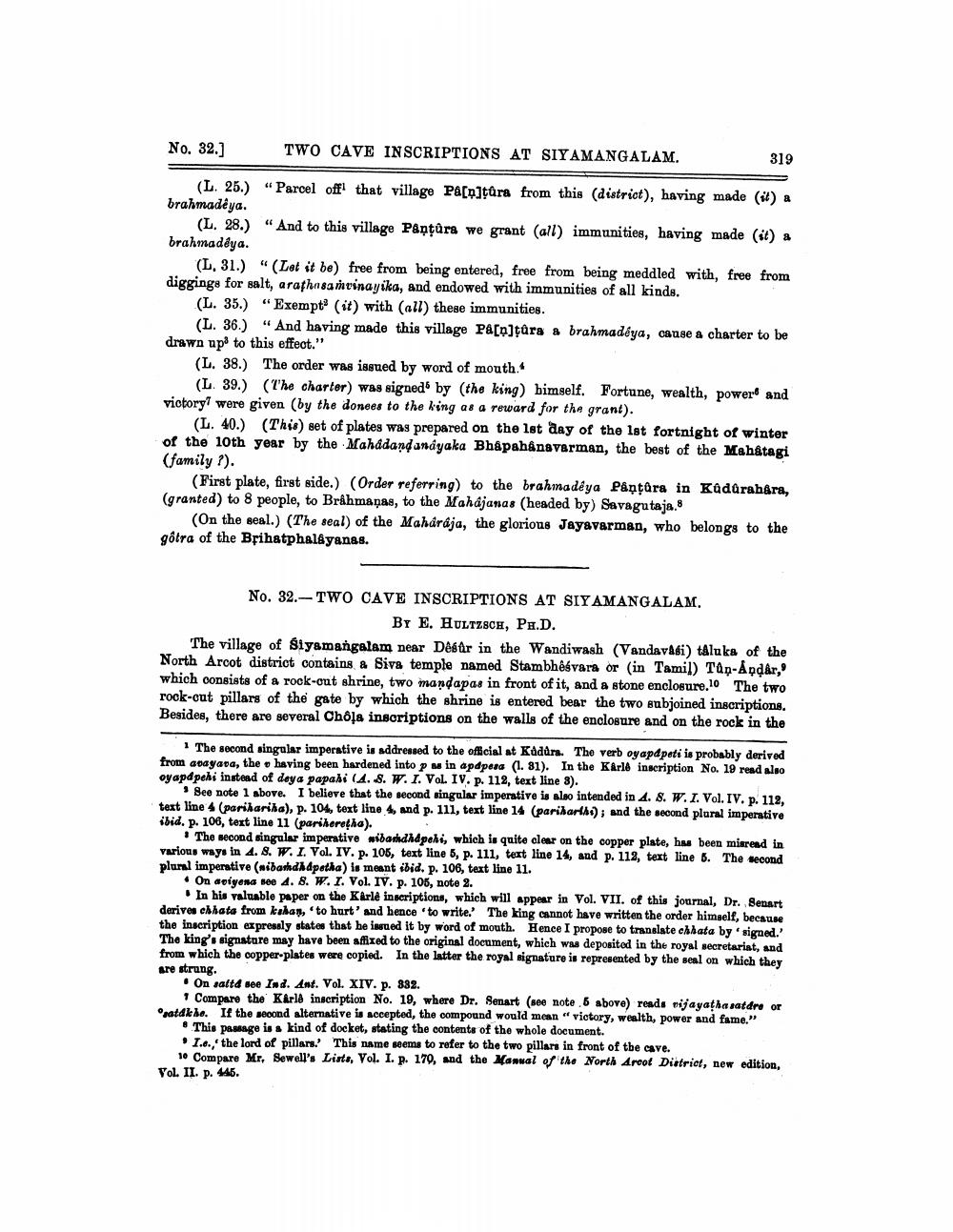________________
No. 32.]
TWO CAVE INSCRIPTIONS AT SIYAMANGALAM.
319
(L. 25.) "Paroel off that village Pa[n]tura from this (district), having made (it) a brahmadêya.
(L. 28.) "And to this village Påņtūra we grant (all) immunities, having made (it) & brahmadêya.
(L. 31.) " (Let it be free from being entered, free from being meddled with, free from diggings for salt, arathn samvinayika, and endowed with immunities of all kinds.
(L. 35.) “Exempt (it) with (all) these immunities.
(L. 36.) “And having made this village Pa[n]tura a brahmadéya, cause a charter to be drawn up to this effect."
(L. 38.) The order was issued by word of mouth.
(L. 39.) (The charter) was signed by the king) bimself. Fortune, wealth, power and viotory were given (by the donces to the king as a reward for the grant).
(L. 40.) (This set of plates was prepared on the lst day of the 1st fortnight of winter of the 10th year by the Mahadandanayaka Bhåpahậnavarman, the best of the Mahâtagi (family ?).
(First plate, first side.) (Order referring) to the brahmadêya Påņtāra in Küdürahera, (granted) to 8 people, to Bråhmaņas, to the Mahajanas (headed by) Savagutaja.S
(On the seal.) (The seal) of the Maharaja, the glorious Jayavarman, who belongs to the gôtra of the Brihatphalfyanas.
No. 32.-TWO CAVE INSCRIPTIONS AT SIYAMANG ALAM,
By E. HULTZSCH, PA.D. The village of Siyamangalam near Desûr in the Wandiwash (Vandavági) tAluks of the North Arcot district contains & Siva temple named Stambhêsvara or (in Tamil) Tan-Åņdar, which consists of a rock-out shrine, two mandapas in front of it, and a stone enclosure. The two rock-cut pillars of the gate by which the shrine is entered bear the two subjoined inscriptions. Besides, there are several Chôļa inscriptions on the walls of the enclosure and on the rock in the
1 The second singular imperative is addressed to the official at Kadars. The verb oyapd peti is probably derived from adayana, the having been hardened into p in a pdpera (1. 81). In the Karlé inscription No. 19 read also oyapd pehi instead of daya papali (4.8.W.I. VL. IV. p. 112, text line 3).
See note 1 above. I believe that the second singular imperative is also intended in 4. 8. W. I. Vol. IV. p. 112, text line 4 (pariharika), p. 104, text line 4, and p. 111, text line 14 (parihari); and the second plural imperative ibid. p. 106, text line 11 (pariheretha).
• The second singular imperative widasidhd peli, which is quite clear on the copper plate, has been misread in various ways in 4.8. W. I. Vol. IV. p. 106, text line 5, p. 111, text line 14, and p. 112, text line 5. The second plural imperative (nibarda dpetha) is meant ibid. p. 106, text line 11.
• On apiyona see 4. 8. W. I. Vol. IV. p. 105, note 2.
In his valuable paper on the Karle inscriptions, which will appear in Vol. VII. of this journal, Dr. Senart deriva chhata from kahan, 'to hurt' and hence to write. The king cannot have written the order himself, because the inscription expressly states that be issued it by word of mouth. Hence I propose to translate chhata by 'signed.' The king's signature may have been affixed to the original document, which was depositod in the royal secretariat, and from which the copper-plates were copied. In the latter the royal signature is represented by the seal on which they are strung.
. On saltd see Ind. Ant. Vol. XIV. p. 832.
1 Compare the Karla inscription No. 19, where Dr. Senart (see note 6 above) reads vijayatha satdre or atdk he. If the second alternative is accepted, the compound would mean " victory, wealth, power and fame.”
* This passage is a kind of docket, stating the contents of the whole document. . I.e.,the lord of pillars.' This name seems to refer to the two pillars in front of the cave.
10 Compare Mr. Sewell's Lists, Vol. I. p. 179, and the Manual of the North Aroof District, new edition, Vol. II. p. 446.




